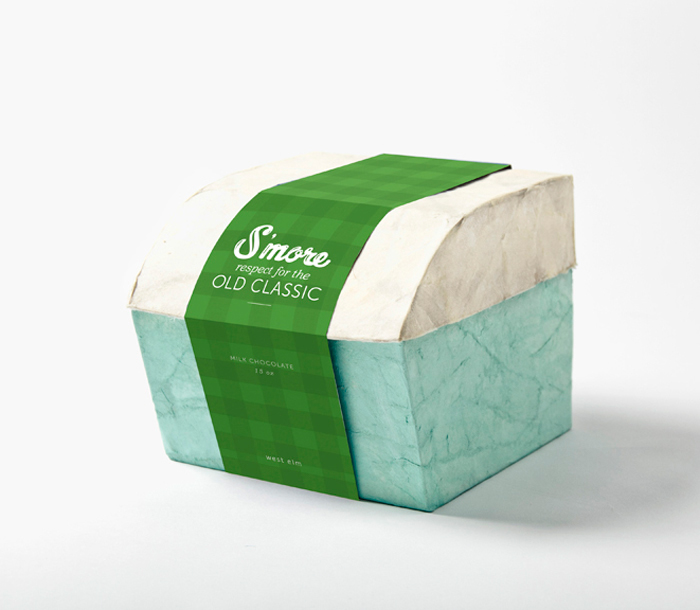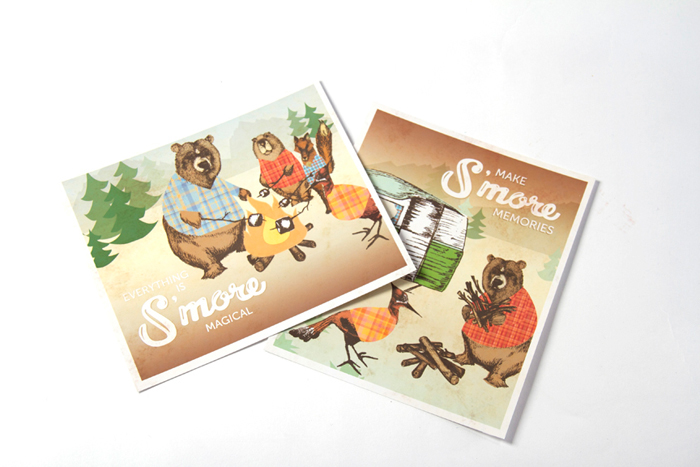S'mores
IOPP's 48 hour re-pack challenge
Rachel Spence, Matthew Palizay, Jamie Sichel, Amanda Brennan, Julia Marye and Ruta Jamenis
Current problem:

The allure of the s’more is its unchanged simplicity. We created a design that celebrates this nostalgic ritual by giving the consumer more freedom to enjoy the experience.
Our design is inspired by the enduring history of creating a s’more. We find ourselves making s’mores when we are gathered with family, friends, and loved ones around a fire, taking a break from our day-to-day routines. Chocolate, graham crackers, and marshmallows have been sandwiched together for over a century without a change in form. Our package is a nod to the carefree and light- hearted mindset that goes hand-in-hand with the s’more.
The form of the package was inspired by the color and shape of a vintage camper. This shape is meant to urge our customer to pick this product up in an emotive response to the quirky and nostalgic packaging. The hip, affluent and environmentally conscious customer at West Elm is attracted by the vibrant colors of our product and drawn in by the story of the camper and the witty headlines.
Our package comes with a postcard that doubles as a design element as well as a memento. The postcard is a sliding divider that sections off the marshmallows from the chocolate and graham crackers. It promotes nostalgia by providing a way to remember your experience either by mail or a virtual social network.
Currently, consumers are purchasing the three elements of a s’more from three companies, packaged in a variety of substrates. We recognized the environmental problems as well as stresses on the consumer that this packaging strategy creates.
In creating this package, we found a unique and practi- cal way to combine three separate elements with a minimal variation in components. We also focused on establishing a dieline that uses a small amount of material creating an economically efficient package in addition to environmentally sustainable package.
Our package is constructed out of unbleached pulp from sugar cane fiber. All color on the container has been printed using soy dyes and inks and the chocolate inside of the container is separated by dissolvable rice papers. All of these materials are renewable, recyclable, and 100% biodegradable thus avoiding any contribution to pollution and hazardous waste.
Our package creates an all-in-one convenience for our customer. Without the hassle of buying multiple boxes and bags of different products, this package provides the perfect portion of s’mores and avoids the potential food waste endured when consumers purchase the three com- ponents separately.
The package is re-sealable, and prevents a mess or wasting food after a night on a campsite or even a night in the backyard.
In conclusion, we have created an environmentally sound package that is more convenient for the consumer and the manufacturer and while creating an emotional experience for the user.
Now, that’s s’more like it!Our design is inspired by the enduring history of creating a s’more. We find ourselves making s’mores when we are gathered with family, friends, and loved ones around a fire, taking a break from our day-to-day routines. Chocolate, graham crackers, and marshmallows have been sandwiched together for over a century without a change in form. Our package is a nod to the carefree and light- hearted mindset that goes hand-in-hand with the s’more.
The form of the package was inspired by the color and shape of a vintage camper. This shape is meant to urge our customer to pick this product up in an emotive response to the quirky and nostalgic packaging. The hip, affluent and environmentally conscious customer at West Elm is attracted by the vibrant colors of our product and drawn in by the story of the camper and the witty headlines.
Our package comes with a postcard that doubles as a design element as well as a memento. The postcard is a sliding divider that sections off the marshmallows from the chocolate and graham crackers. It promotes nostalgia by providing a way to remember your experience either by mail or a virtual social network.
Currently, consumers are purchasing the three elements of a s’more from three companies, packaged in a variety of substrates. We recognized the environmental problems as well as stresses on the consumer that this packaging strategy creates.
In creating this package, we found a unique and practi- cal way to combine three separate elements with a minimal variation in components. We also focused on establishing a dieline that uses a small amount of material creating an economically efficient package in addition to environmentally sustainable package.
Our package is constructed out of unbleached pulp from sugar cane fiber. All color on the container has been printed using soy dyes and inks and the chocolate inside of the container is separated by dissolvable rice papers. All of these materials are renewable, recyclable, and 100% biodegradable thus avoiding any contribution to pollution and hazardous waste.
Our package creates an all-in-one convenience for our customer. Without the hassle of buying multiple boxes and bags of different products, this package provides the perfect portion of s’mores and avoids the potential food waste endured when consumers purchase the three com- ponents separately.
The package is re-sealable, and prevents a mess or wasting food after a night on a campsite or even a night in the backyard.
In conclusion, we have created an environmentally sound package that is more convenient for the consumer and the manufacturer and while creating an emotional experience for the user.
Now, that’s s’more like it!
Our design is inspired by the enduring history of creating a s’more. We find ourselves making s’mores when we are gathered with family, friends, and loved ones around a fire, taking a break from our day-to-day routines. Chocolate, graham crackers, and marshmallows have been sandwiched together for over a century without a change in form. Our package is a nod to the carefree and light- hearted mindset that goes hand-in-hand with the s’more.
The form of the package was inspired by the color and shape of a vintage camper. This shape is meant to urge our customer to pick this product up in an emotive response to the quirky and nostalgic packaging. The hip, affluent and environmentally conscious customer at West Elm is attracted by the vibrant colors of our product and drawn in by the story of the camper and the witty headlines.
Our package comes with a postcard that doubles as a design element as well as a memento. The postcard is a sliding divider that sections off the marshmallows from the chocolate and graham crackers. It promotes nostalgia by providing a way to remember your experience either by mail or a virtual social network.
Currently, consumers are purchasing the three elements of a s’more from three companies, packaged in a variety of substrates. We recognized the environmental problems as well as stresses on the consumer that this packaging strategy creates.
In creating this package, we found a unique and practi- cal way to combine three separate elements with a minimal variation in components. We also focused on establishing a dieline that uses a small amount of material creating an economically efficient package in addition to environmentally sustainable package.
Our package is constructed out of unbleached pulp from sugar cane fiber. All color on the container has been printed using soy dyes and inks and the chocolate inside of the container is separated by dissolvable rice papers. All of these materials are renewable, recyclable, and 100% biodegradable thus avoiding any contribution to pollution and hazardous waste.
Our package creates an all-in-one convenience for our customer. Without the hassle of buying multiple boxes and bags of different products, this package provides the perfect portion of s’mores and avoids the potential food waste endured when consumers purchase the three com- ponents separately.
The package is re-sealable, and prevents a mess or wasting food after a night on a campsite or even a night in the backyard.
In conclusion, we have created an environmentally sound package that is more convenient for the consumer and the manufacturer and while creating an emotional experience for the user.
Now, that’s s’more like it!Our design is inspired by the enduring history of creating a s’more. We find ourselves making s’mores when we are gathered with family, friends, and loved ones around a fire, taking a break from our day-to-day routines. Chocolate, graham crackers, and marshmallows have been sandwiched together for over a century without a change in form. Our package is a nod to the carefree and light- hearted mindset that goes hand-in-hand with the s’more.
The form of the package was inspired by the color and shape of a vintage camper. This shape is meant to urge our customer to pick this product up in an emotive response to the quirky and nostalgic packaging. The hip, affluent and environmentally conscious customer at West Elm is attracted by the vibrant colors of our product and drawn in by the story of the camper and the witty headlines.
Our package comes with a postcard that doubles as a design element as well as a memento. The postcard is a sliding divider that sections off the marshmallows from the chocolate and graham crackers. It promotes nostalgia by providing a way to remember your experience either by mail or a virtual social network.
Currently, consumers are purchasing the three elements of a s’more from three companies, packaged in a variety of substrates. We recognized the environmental problems as well as stresses on the consumer that this packaging strategy creates.
In creating this package, we found a unique and practi- cal way to combine three separate elements with a minimal variation in components. We also focused on establishing a dieline that uses a small amount of material creating an economically efficient package in addition to environmentally sustainable package.
Our package is constructed out of unbleached pulp from sugar cane fiber. All color on the container has been printed using soy dyes and inks and the chocolate inside of the container is separated by dissolvable rice papers. All of these materials are renewable, recyclable, and 100% biodegradable thus avoiding any contribution to pollution and hazardous waste.
Our package creates an all-in-one convenience for our customer. Without the hassle of buying multiple boxes and bags of different products, this package provides the perfect portion of s’mores and avoids the potential food waste endured when consumers purchase the three com- ponents separately.
The package is re-sealable, and prevents a mess or wasting food after a night on a campsite or even a night in the backyard.
In conclusion, we have created an environmentally sound package that is more convenient for the consumer and the manufacturer and while creating an emotional experience for the user.
Now, that’s s’more like it!
The Solution:






The Design Process:

This project is a group effort by Rachel Spence, Matthew Palizay, Jamie Sichel, Amanda Brennan, Julia Marye and Ruta Jamenis


